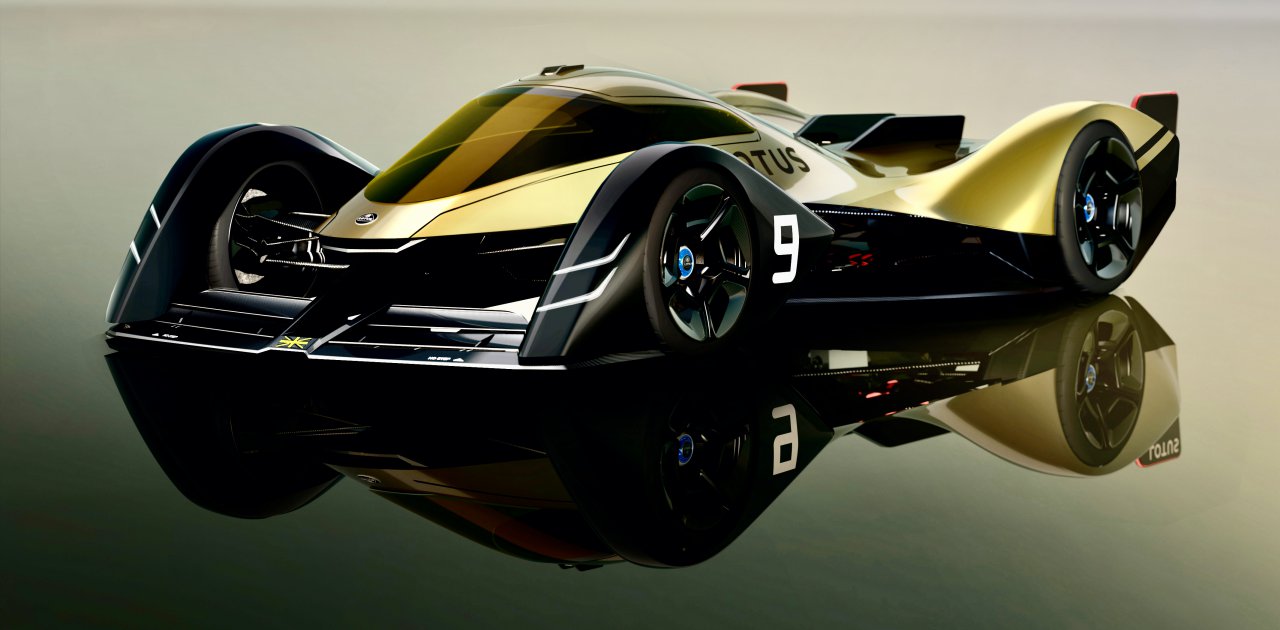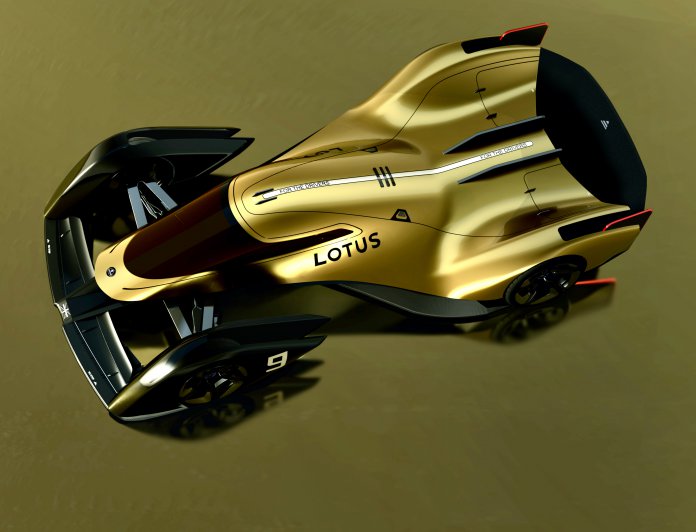While working with Renault’s Alpine division on a next-generation electric-powered sports car as well as ramping down production of the Elise, Exige and Evora in preparation for its own Type 131 model, Lotus has found time to create a design study for “the electric race car for 2030.”
Callled E-R9, Lotus aerodynamicist Richard Hill says the car, with “morphing” body panels and aero control surfaces, is “partly driven like a car and partly flown like a fighter jet.”

“Finished in striking black and gold – a clear nod to Lotus’ pioneering motorsport heritage that led to 13 Formula 1 championship titles – the EV features a sleek fighter jet-style canopy centrally mounted in a delta-wing upper body,” Lotus said in its announcement.
“Innovations include advanced active aerodynamics with ‘morphing’ body panels and vertically mounted control surfaces to assist with high-speed cornering… The car has been created as a technology showcase of its philosophy, capability and innovative spirit in the fields of advanced electrified powertrains and aerodynamics.”
Lotus said E-R is short for Endurance-Racer and 9 is the concept’s racing number, “carefully chosen in tribute to Lotus’ racing past. It was in a Lotus Mark IX that the race team made its debut appearance at the Le Mans 24 Hours, with company founder Colin Chapman among the drivers competing.”

Lotus noted that the Mark IX raced at Le Mans in 1955, meaning that 2030 would mark the 75th anniversary year.
Joining Hill in leading the E-R9 program were design director Russell Carr and Louis Keer, head platform engineer for the Lotus Evija electric hypercar. The E-V9’s powertrain is based on the Evija’s. Keer also is technical director for Chinese automaker Geely’s international motorsports program.
“What we’ve tried to do is to push the boundaries of where we are technically today and extrapolate into the future,” Hill is quoted in the Lotus news release. “The Lotus E-R9 incorporates technologies which we fully expect to develop and be practical. Lotus has an amazing history of developing unique solutions, and we’ve done it many times in motorsport and with our road cars.”

Among those technologies showcased on the E-R9 are body panels with “active” surfaces that can change based either on aerodynamic loading or by driver-activated controls. The goal is to minimize drag on straightaways and maximum downforce in corners.
With vertical control surfaces at the rear to generate aerodynamic forces to help the car change direction, the driver also acts to a degree as a pilot.
Lotus notes that the E-R9 is detailed in a special 32-page supplement in the March issue of evo magazine.
For additional information, Lotus points to its blog website.






Super gorgeous.Dreamy so.
But is it actually even “conceptual” as a race car?
With only a toss out of “….showcase of its philosophy, capability and innovative spirit in the fields of advanced electrified powertrains…” to indicate they must be excusing the lack of designing a place for any possible engine (sort of an important component of any, but especially a race) car in favor of some smaller electric motors…it still seems the reality of need for a power source (batteries) would have anything like this fall far short of possible.
And if your going to dream the impossible dream – doing it in JPS colors makes it yet more vivid.
Well, batteries aren’t always going to be rectangular slabs, and motor-in-wheel has been done, so why not wheel as rotor, axle as stator?
Those wheels as drawn are plenty large for major hp equivalent at all four corners- with EM brakes!-, and the undertray and all those oddly shaped nooks and crannies could certainly hold future polymorphic batteries.
Also, to be truly a Johnny Player Special redux, the primary colour would have to be black, with gold trim.
My take? It’s a delicious dream of what might be, if the petro industry can be quelled long enough. Looks like a foil wrapped tasty Godiva chocolate- mmm!